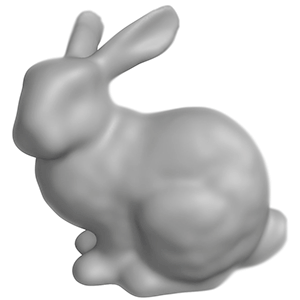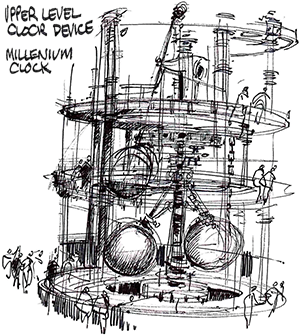A sleeper (called a Q-car in the UK) is a car that has high performance and an unassuming exterior. Sleeper cars are termed such because their exterior looks little or no different from a standard or economy-class car. In some cases the car appears worse due to seeming neglect on the owner’s part, typically referred to as ‘all go and no show.’ While appearing to be a standard or neglected car, internally they are modified to perform at higher performance levels. The American nomenclature comes from the term sleeper agent, while the British term derives from the Q-ships used by the Royal Navy.
American actor Paul Newman famously drove a 1963 VW Beetle convertible with a 300-horsepower engine, racing suspension and five-speed gearbox. The back seats were removed to make room for the 351-cubic-inch Ford engine.
read more »
Sleeper
Stanford Bunny
The Stanford Bunny is a computer graphics test model developed in 1994 at Stanford University. The Bunny consists of data describing 69,451 triangles determined by 3D scanning a ceramic figurine of a rabbit.
The data can be used to test various graphics algorithms; including polygonal simplification, compression, and surface smoothing. By today’s standards in terms of geometric complexity and triangle count, it is considered a simple model.
Stanford 3D Scanning Repository
The Stanford 3D Scanning Repository is a collection of freely usable 3d models scanned from real objects. The models tend to have very high polygon counts (the largest has almost 30 million). According to the repository, ‘In recent years, the number of range scanners and surface reconstruction algorithms has been growing rapidly. Many researchers, however, do not have access to scanning facilities or dense polygonal models. The purpose of this repository is to make some range data and detailed reconstructions available to the public.
The models in this archive are commonly used in the graphics, visualization, and vision communities. Things people have done with these models include simplification, multi-resolution representation, curved surface fitting, compression, texture mapping, modeling, deformation, animation, physically-based simulation, texture synthesis, and rendering. The Stanford Bunny is particularly widely used.
Rosetta Project
The Rosetta Project is a global collaboration of language specialists and native speakers working to develop a contemporary version of the historic Rosetta Stone to last from 2000 to 12,000 CE; it is run by the Long Now Foundation. Its goal is a meaningful survey and near permanent archive of 1,500 languages. Some of these languages have fewer than one thousand speakers left in the world. Others are considered to be dying out because government centralization and globalization are increasing the prevalence of English and other major languages. The intention is to create a unique platform for comparative linguistic research and education, as well as a functional linguistic tool that might help in the recovery or revitalisation of lost languages in the future.
The Project is creating this broad language archive through an open contribution, open review process similar to the strategy that created the original Oxford English Dictionary. The resulting archive will be publicly available in three different media: a micro-etched nickel alloy disc three inches (7.62 cm) across with 2,000 year life expectancy; a single volume monumental reference book; and a growing online archive.
Long Now Foundation
The Long Now Foundation, established in 1996, is a private organization that seeks to become the seed of a very long-term cultural institution. It aims to provide a counterpoint to what it views as today’s ‘faster/cheaper’ mindset and to promote ‘slower/better’ thinking. The Long Now Foundation hopes to ‘creatively foster responsibility’ in the framework of the next 10,000 years, and so uses 5-digit dates to address the Year 10,000 problem (e.g. by writing 02011 rather than 2011).
The Foundation has several ongoing projects, including a 10,000-year clock known as the ‘Clock of the Long Now,’ the Rosetta Project, the Long Bet Project, the open source Timeline Tool (also known as Longviewer), the Long Server and a monthly seminar series.
read more »
Stephen Hawking
Stephen Hawking (b. 1942) is an English theoretical physicist and cosmologist, whose scientific books and public appearances have made him an academic celebrity. He is known for his contributions to the fields of cosmology and quantum gravity, especially in the context of black holes (he first predicted that black holes emit radiation, which is today known as Hawking radiation).
He has also achieved success with works of popular science in which he discusses his own theories and cosmology in general. Hawking has a motor neurone disease that is related to ALS (Lou Gehrig’s disease), a condition that has progressed over the years and has left him almost completely paralyzed.
read more »










